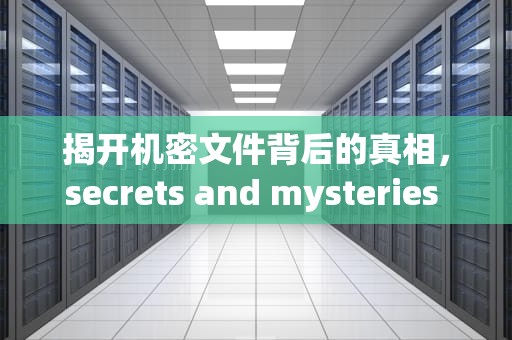本文目录导读:

In the digital age, classified documents have become a cornerstone of modern intelligence gathering, national security, and corporate strategy. These documents, often referred to as "classified" or "secret," are protected by strict laws and protocols to ensure they are only accessible to authorized individuals and institutions. However, the world of classified documents is far more complex and intriguing than one might initially think. This article delves into the history, significance, and controversies surrounding classified documents, shedding light on their role in shaping the modern world.
The concept of classified documents dates back to ancient civilizations, where secret records were kept to maintain political, military, or religious power. For example, the Spartans used a device called a Scytale to encrypt messages, ensuring that only those with the correct staff could read them. Similarly, ancient Egypt used hieroglyphs to hide secret information from the public. Fast forward to the modern era, classified documents have evolved significantly, becoming a critical tool for governments, corporations, and even individuals who wish to protect their sensitive information.
The development of technology has revolutionized the way classified documents are created, distributed, and accessed. Early methods relied on physical means, such as sealed envelopes, padlocked boxes, and even buried treasure. With the advent of the printing press and the spread of knowledge during the Renaissance, the need for classified documents grew, as did the sophistication of the methods used to protect them.
Classified documents play a pivotal role in maintaining national security, economic stability, and social order. Governments use them to protect sensitive information from foreign intelligence agencies, ensuring that no nation has an unfair advantage in global affairs. For example, the U.S. Department of Defense releases classified information about military operations, but even that information is subject to strict controls and time limits.
In the corporate world, classified documents are used to protect trade secrets, intellectual property, and competitive advantages. Companies such as Google, Apple, and Amazon have faced scrutiny over their classified documents, as the release of such information can have far-reaching consequences. The release of classified documents by corporations has often been a point of contention, with some arguing that they should be made public to foster innovation and competition.
The legal protection of classified documents is a complex issue, with varying laws and regulations governing their creation, distribution, and access. In the United States, the National Security Act of 1951 and the Foreign Intelligence Surveillance Act of 1978 provide a framework for the protection of classified information. Similarly, countries like the European Union have strict laws, such as the General Data Protection Regulation (GDPR), to ensure that personal data is protected.
Ethically, the release of classified documents raises concerns about privacy, freedom of information, and the potential for misuse. While some argue that the public has a right to know, others believe that classified documents are necessary to maintain national security and prevent global threats. The debate over the release of classified documents is ongoing, with no clear resolution in sight.
The digital revolution has brought about significant changes in how classified documents are created, distributed, and accessed. Digital classified documents are often stored in encrypted formats, such as PDFs or encrypted files, to ensure that only authorized individuals can access them. These documents are distributed through secure channels, such as encrypted email or secure websites, to prevent unauthorized access.
The use of blockchain technology has further enhanced the security of classified documents, as blockchain is inherently resistant to tampering and unauthorized modification. This makes classified documents stored on blockchain platforms highly secure, as any attempt to alter the document would be immediately detectable.
As technology continues to evolve, so too will the nature of classified documents. The rise of artificial intelligence and machine learning has the potential to revolutionize the way classified documents are created, distributed, and accessed. These technologies could make it easier to encrypt and decrypt classified documents, as well as identify patterns and trends in classified content.
In addition, the use of virtual reality and augmented reality could enhance the security of classified documents by providing users with a more immersive experience. For example, users could access classified documents through a virtual reality headset, making it more difficult to eavesdrop or copy sensitive information.
Classified documents are a cornerstone of modern intelligence, security, and corporate strategy. From their ancient origins to their digital form, classified documents have played a vital role in shaping the world we live in today. However, their complexity and significance also raise ethical and legal questions about their release and use. As technology continues to evolve, the future of classified documents will undoubtedly remain a topic of debate, with the potential for new innovations and challenges to shape the way we protect and access sensitive information.
随着互联网的普及和信息技术的飞速发展台湾vps云服务器邮件,电子邮件已经成为企业和个人日常沟通的重要工具。然而,传统的邮件服务在安全性、稳定性和可扩展性方面存在一定的局限性。为台湾vps云服务器邮件了满足用户对高效、安全、稳定的邮件服务的需求,台湾VPS云服务器邮件服务应运而生。本文将对台湾VPS云服务器邮件服务进行详细介绍,分析其优势和应用案例,并为用户提供如何选择合适的台湾VPS云服务器邮件服务的参考建议。

工作时间:8:00-18:00
电子邮件
1968656499@qq.com
扫码二维码
获取最新动态
